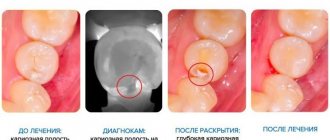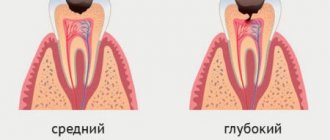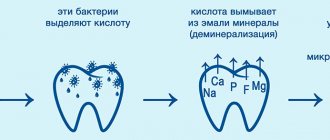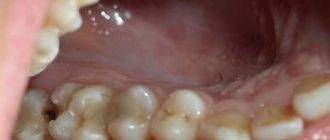Content
- Causes of bleeding
- Possible complications
- Treatment regimens
- Prevention
If your tooth is bleeding, gum disease may be the cause. Inflammatory processes develop as a result of gingivitis and periodontitis, in the absence of proper oral hygiene. If there is pathology, bleeding can be caused even by regular brushing of teeth.
To fix a problem, you need to understand the cause of its occurrence. In some cases, it will be enough to eliminate the source of the problem; sometimes the approach to treatment should be complex, using medications.
PROMOTION
Dental restoration, installation of fillings
from 2200 rub.
If pain occurs when pressing on a filled tooth
It happens that outwardly the unit looks fine (the filling is sealed, the crown has not changed its color), but, nevertheless, painful symptoms periodically make themselves felt. This situation is considered normal only in the first day after the filling is installed. Then the pain should disappear. If it persists for a long time, then something is wrong.
Most likely, an inflammatory reaction has developed. She needs to be docked. To do this, you should make an appointment with your dentist. The doctor will conduct an in-person examination, instrumental examination, and take pictures. This will allow him to understand why the pain appeared and, based on the information received, create a progressive treatment plan.
Main causes of bleeding
Lack of proper oral hygiene. Injury to the gums and the formation of bruises can be caused by a hard toothbrush. Improper flossing can also cause injury.
Plaque and tartar, the accumulation of many microorganisms contribute to the rejection of teeth from the gums. The resulting gap fills with blood. In order not to provoke such a problem, you should brush your teeth thoroughly and regularly visit the dentist for preventive purposes.
A risk factor is changes in hormonal levels, including during pregnancy, disruption of the internal systems of the body, or simply with age. The result is looseness of the walls of blood vessels and their slight injury.
Infectious diseases of the oral cavity that develop as a result of the accumulation of harmful microorganisms and bacteria. The reason is poor oral hygiene, lack of timely treatment and professional cleaning. The result is bleeding from the tooth canal.
Cervical caries - causes, treatment, prevention
Despite the obvious good visualization of the defect, the treatment of cervical caries is by no means simple due to several reasons:
- proximity of the gum edge to the working field, the likelihood of blood/pus from inflamed soft tissues getting there;
- the need for gum retraction to access the gingival wall of the carious cavity;
- difficulties in instrumentation of the cavity due to the proximity of the pulp, high risk of opening the pulp chamber;
- the problem of complete isolation of the working field from saliva, especially if the defect extends to the root part of the tooth;
- poor adhesion of the filling material to the gingival surface, especially since the adhesion of the filling to root dentin is much worse than to coronal dentin;
- the need to ensure macromechanical retention of the installed filling, because Adhesion alone is not enough to achieve reliable fixation of the restoration.
Therapeutic manipulations in the cervical area are quite painful, so the preparation of deep cavities and their filling takes place under anesthesia. In children, the injection site is first anesthetized by applying a gel.
Treatment at the spot stage
At the very beginning of the disease, when the enamel began to lose its shine and a stain appeared, you can do without using a drill, trying to stop demineralization with special preparations. Remineralizing therapy is carried out through applications to the cleaned and dried surface of the teeth.
Popular means:
- enamel-sealing liquid from HumanChemie (Germany);
- Gluflutored;
- foam “Flairesse” (Germany)
- "Topical APF Gel" (USA).
- Tyc Mousse (Japan) and others.
The preparations contain fluorine and calcium in the form of ions. Treatment of cervical caries is complex. About 10 procedures are required (the doctor alternately applies calcium compounds and highly active fluoride to the enamel). To consolidate the result, products containing fluorides are prescribed - toothpastes, mouthwashes. With proper therapy, the enamel restores its structure and shine. After 1-2 months, it is recommended to visit the dentist to monitor the effectiveness of the treatment.
Treatment at the superficial stage
When cervical caries passes into the superficial stage, it is sometimes possible to get by by grinding off the rough layer and carrying out remineralization therapy, but such tactics are more suitable for children. As a rule, patients rarely go to the dentist in the first stages of carious disease, so the doctor prefers to carry out full treatment with cavity preparation. At the superficial stage, the specialist cleans the tooth of plaque, removes the rough layer, and etches the enamel with gel to improve its susceptibility to the restorative material. A liquid composite of a suitable shade is applied to the surface, which fills the voids of the changed enamel. The doctor polymerizes the material with a lamp, it hardens, being completely invisible on the tooth. This treatment will take about 15-25 minutes and no anesthesia is required.
Treatment at the middle and deep stages
Therapeutic measures for diagnosing mid-stage cervical caries include:
- anesthesia;
- isolation of the working field;
- opening the cavity with a drill;
- removal of changed (softened) tissues;
- antiseptic treatment of the cavity;
- drying the bottom and walls;
- application of insulating and therapeutic pads;
- filling the defect;
- grinding and polishing of the filling.
In modern clinics, for the treatment of cervical caries, complex technologies are used, involving the use of several materials and adhesive systems, which makes it possible to successfully fill gingival and subgingival defects with the restoration of the tooth’s functional properties.
What complications are possible?
When, in addition to bleeding, there is an unpleasant odor coming from the mouth, you should immediately visit the dentist. At home, you can only rinse your mouth with an antiseptic. If such symptoms are not followed by treatment, complications will not be long in coming.
Many bacteria increase the risk of cyst formation; cystic formations can only be removed surgically.
The pathological process will cause destruction of the filling and crown, inflammation of the gum tissue. Treatment includes the use of medications and surgical removal of the infection.
The lack of timely treatment of pulpitis and caries aggravates the situation and ongoing inflammation completely destroys the teeth.
To eliminate the risk of complications, it is necessary to carry out a course of treatment in a timely manner.
Tooth decay
In the early stages of tooth decay, white spots or spots appear on the tooth enamel. The affected areas lose their natural shine and become dull. A thorough examination reveals the presence of damage to the enamel. If the process of tooth decay progresses, the affected area becomes brown or black, it is necessary to diagnose dental treatment. The damage is initially noticeable as a small dark spot or spots that gradually increase in size (over several months to several years) and often lead to actual tooth decay.
The treatment regimen includes:
- systematic professional teeth cleaning – removal of plaque and tartar;
- a course of physiotherapeutic procedures to relieve inflammation;
- sanitation of the oral cavity.
The next stage of treatment is home therapy: rinsing with disinfecting solutions (salt and soda, chlorhexidine).
For a purulent infection, the patient is prescribed antibiotics.
At home, you can independently use traditional medicine methods, including decoctions and infusions of medicinal plants:
- oak bark;
- chamomile flowers;
- sage herbs.
You can use these decoctions and calendula tincture as lotions on problem areas of the mouth.
Use of pharmaceutical products:
- fluoridated toothpastes with the addition of medicinal herbal extracts;
- dental anti-inflammatory gels (Cholisal);
- vitamin complexes.
Why do stains appear on enamel?
Pigmentation, whitish areas on milk and permanent teeth occur in 40% of children. Some babies have barely noticeable dark dots and streaks, while others have spots reaching more than 5 mm. White spots on a child’s teeth do not stand out against wet enamel, so parents do not always notice them. Only after drying the teeth do the defects become clearly visible.
The main reason for the appearance of yellowish and whitish areas on teeth is enamel hypoplasia. This is a defect caused by a violation of metabolic processes during the formation and mineralization of teeth. Adverse factors can affect tooth germs at the stage of intrauterine development and up to 6–8 years. Diseases during pregnancy of the expectant mother lead to underdevelopment of the enamel of the mammary units. Hypoplasia of permanent teeth is preceded by disturbances in mineral metabolism in a child.
The location of areas with underdeveloped enamel depends on the age at which the baby suffered the disease. Spots on the front teeth of children appear due to diseases suffered from 5 to 9 months of life. During this period, incisors and fangs are formed. The timing of tooth formation is not the same, the spots are at different levels. With a long-term disease and significant metabolic disturbances, areas of hypoplasia are located throughout the crown.
The depth of enamel changes depends on the severity of the disease. Chalky stains on teeth are a mild degree of hypoplasia caused by minor short-term diseases. Smooth glossy spots do not cause painful discomfort. Severe pathologies lead to profound changes in the enamel. Teeth erupt brown, with areas of exposed dentin and erosion of the enamel layer.
If dark spots appear on your child’s teeth, sign up for a consultation at our Family Dentist clinic. We will establish the correct diagnosis and choose an effective treatment method.
The procedure for tasting wines through the eyes of dentists
During tastings, we are used to alternating wines in this order: first sparkling wines, then still whites, roses and finally red wines. From a dental point of view, this is incorrect and harmful to the color of teeth. Wine has low pH values, with white and sparkling wines having a lower pH than red ones. When white wine hits the surface of the teeth, wines with a lower pH value begin the process of erosion, the tooth becomes more porous, and then red wine stains the teeth more. Based on this, taking into account the difference in pH between wines, you should drink red wines first, and then white and finally sparkling wines. In this order, we will be more careful about the color of our teeth.
Causes of enamel hypoplasia
| Stains on a child’s permanent teeth provoke: | Stains on primary teeth occur due to: |
|
|
Problem
For dentists, tooth discoloration is one of the important problems that they solve with whitening, and this technology is constantly being improved. This problem has a name - discoloration. The term means a pathological change in color in the enamel area.
Discoloration can be of two types. The first is endogenous, that is, the color given to us by nature, the shade with which we were born and live. The second is exogenous, these are changes from external stimuli. Most often it is red wine, then, depending on the strength of its effect, tea, coffee, tobacco, some berries and fruits. Even sauces, such as soy and pomegranate. The reason is the pigments that these products contain. If giving up tobacco is difficult, but possible, then eliminating food and wine from your diet is impossible.
© Kelsey Chance/Unsplash











